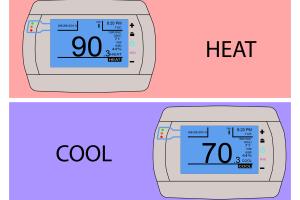Mastering Lux Thermostat Programming: A Step-by-Step Guide for Energy Efficiency

-
Quick Links:
- Introduction
- Understanding Lux Thermostats
- Types of Lux Thermostats
- Step-by-Step Programming Guide
- Advanced Features of Lux Thermostats
- Troubleshooting Common Issues
- Expert Insights on Thermostat Programming
- Case Studies: Real-World Applications
- Maximizing Energy Savings
- FAQs
Introduction
In an era where energy efficiency is paramount, understanding how to program your Lux thermostat can significantly impact your home’s energy consumption and comfort level. This comprehensive guide will walk you through the intricacies of programming a Lux thermostat, ensuring you maximize its potential while saving on energy costs.
Understanding Lux Thermostats
Lux thermostats are widely recognized for their user-friendly interfaces and reliable performance. They offer a range of features that can help homeowners maintain a comfortable temperature while conserving energy. Understanding the basic functionalities of your Lux thermostat is the first step in effective programming.
What is a Lux Thermostat?
A Lux thermostat is a device that controls your home’s heating and cooling systems. It can be operated manually or programmed to automatically adjust temperatures based on your schedule.
Benefits of Using a Lux Thermostat
- Energy savings
- Increased comfort
- Easy-to-use interface
- Customizable settings
Types of Lux Thermostats
Lux offers various models of thermostats, including digital, programmable, and smart versions. Each type has unique features catering to different user needs.
Digital vs. Programmable
Digital thermostats provide a simple way to control temperature settings, while programmable thermostats allow users to set schedules for different times of the day.
Smart Thermostats
Smart thermostats, such as the Lux Kono, offer advanced features like remote access through smartphones, learning capabilities, and integration with home automation systems.
Step-by-Step Programming Guide
Programming your Lux thermostat is a straightforward process. Follow these steps for effective programming:
Step 1: Gather Necessary Information
- Your desired temperature settings
- Your schedule for weekdays and weekends
Step 2: Access the Programming Mode
To enter programming mode, press the "Menu" button on your thermostat. Navigate through the options until you find "Program" or "Schedule."
Step 3: Set Your Weekday Schedule
Most Lux thermostats allow you to set different temperatures for morning, day, evening, and night. Choose your desired temperatures for each time slot.
Step 4: Set Your Weekend Schedule
Repeat the process for your weekend settings, ensuring you account for any changes in routine.
Step 5: Review and Save Settings
After entering all settings, review them for accuracy. Save the settings by pressing the "Done" or "Save" button.
Advanced Features of Lux Thermostats
Many Lux thermostat models come equipped with advanced features that enhance their usability and efficiency.
Wi-Fi Connectivity
Smart Lux thermostats can connect to Wi-Fi, allowing you to control your home’s temperature remotely using a smartphone app.
Energy Usage Reports
Some models provide detailed energy usage reports, helping you understand your energy consumption patterns and make informed adjustments.
Troubleshooting Common Issues
While programming your Lux thermostat should be a hassle-free process, issues can arise. Here are some common problems and their solutions.
Thermostat Not Responding
If your thermostat is unresponsive, check the batteries and ensure the device is properly powered.
Incorrect Temperature Readings
If the temperature displayed is incorrect, ensure the thermostat is not placed near heat sources or drafts that may affect its readings.
Expert Insights on Thermostat Programming
HVAC experts recommend regularly reviewing and adjusting your thermostat settings to adapt to seasonal changes, ensuring optimal energy savings and comfort.
Case Studies: Real-World Applications
Several homeowners have reported significant energy savings after programming their Lux thermostats effectively. For example, a family in Colorado reduced their energy bills by 20% by adopting a consistent schedule.
Maximizing Energy Savings
Utilize the following tips to maximize your energy savings with your Lux thermostat:
- Lower the temperature at night or when away.
- Utilize the “Away” setting when you're not home.
- Regularly maintain your HVAC system for efficiency.
FAQs
1. How do I reset my Lux thermostat?
To reset, press and hold the “Reset” button until the screen goes blank, then release it.
2. Can I control my Lux thermostat remotely?
Yes, if you have a smart Lux thermostat, you can control it via a smartphone app.
3. What is the best temperature setting for energy savings?
Setting your thermostat to 68°F in winter and 78°F in summer is recommended for optimal energy savings.
4. How do I change the batteries in my Lux thermostat?
Open the battery compartment, remove old batteries, and insert new ones following the + and - signs.
5. Is programming necessary for my Lux thermostat?
While not necessary, programming helps maintain comfort and reduce energy costs.
6. How often should I check my thermostat settings?
It’s advisable to review your settings seasonally or whenever your schedule changes.
7. What should I do if my thermostat displays an error code?
Refer to the user manual for the specific error code and troubleshooting steps.
8. Can I program different schedules for weekdays and weekends?
Yes, most Lux thermostats allow separate programming for weekdays and weekends.
9. What temperature should I set when I’m away from home?
Set the thermostat to around 10°F lower than your usual setting to save energy.
10. How do I know if my Lux thermostat is compatible with my HVAC system?
Check the product specifications or consult with a professional HVAC technician.
Random Reads
- How to reformat a laptop
- How to reformat external hard drive
- Ultimate guide scrubbing acrylic bathtub
- How to open master lock without code
- How to open nintendo switch kickstand
- Report block gmail account
- Repurpose atx power supply
- How to wire a telephone
- How to win at dice
- How to win at simcity 3000